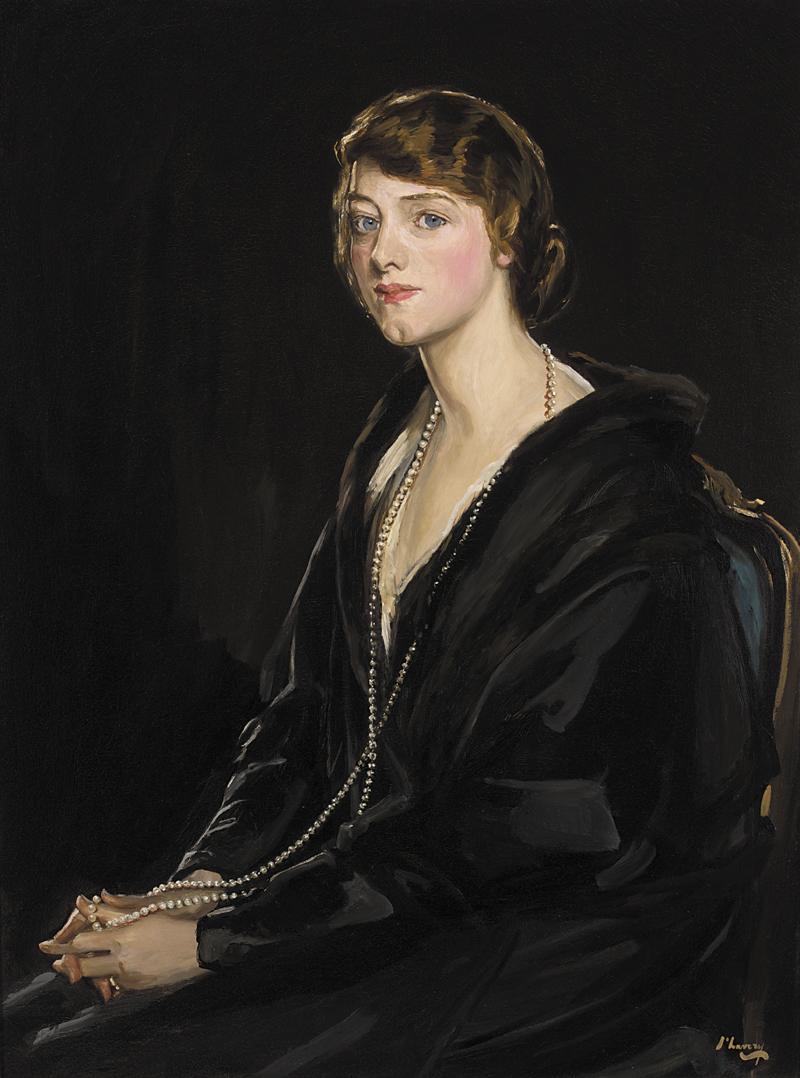
|

|
|
Sir John Lavery -- Irish painter 1923 Private collection Oil on canvas 102 x 76cm. (40 x 30 in) signed; also signed, inscribed with the sitter's name and dated 1923 on the reverse Jpg: Sothebys
From Sothebys In the twenties Lavery sought to modernize his portraiture to meet new challenges and reflect social change. The principal characteristics of the genre prior to the Great War were now rejected. Full-length portraits and small, rapid, preparatory sketches for which there had been enthusiasm among collectors, were out of favour. The critical distance was best described by James Laver when, after Sargent's death in 1925, he declared that this painter's whole world had 'hit a sunken reef.' The glitter of Edwardian society, its imperial pomp and mercantile power was permanently tarnished by the War. Tastes had changed. And the younger post-war generation of the Jazz Age, exemplified by the dashing, playboy Prince of Wales, looked for more immediate pleasures. Lavery was keen to respond to these new conditions. He developed the new genre of the 'portrait interior', seen in embryo in pre-war works like La Lecture. Sitters now 'sat' rather than 'stood', and half-lengths which enabled more concentration on facial characteristics, were more common. As the Portrait of Mrs Bowen-Davies indicates however, handling was not completely sacrificed to the new modernity. The painter retains a simple shorthand that enables the folds of the sitter's coat to be stated with great economy in a very few strokes. She is arranged in such a way that the eye connects the hands and head of the figure on a diagonal for which there is a subtle counterpoint in the curve of chair-back and the back of Mrs Bowen-Davies' shoulders. Where formerly a sitter might wear a picture hat and be swathed in layers of lace, this young woman goes bare-headed, her hair is fashionably short and her long elegant neck is adorned by a single string of pearls. For precedents for this kind of portraiture, Lavery could look to Raeburn, whose half- and three quarter-length figures address the spectator with equal directness. In such works he was in competition with younger painters like William Orpen and Ambrose McEvoy, for whom the grand rhetoric of Sargent operated on a different set of rules. Mrs Bowen-Davies's portrait developed the new template which is evident in its companion portrait at the 1924 Academy, the suave half-length of The Marquis of Londonderry in the Robes of Chancellor of Queens University, Belfast (coll. Queen's University, Belfast). At the time of going to press the precise identity of the sitter remains obscure. The suggestion has been made that this is the wife or relative of the American painter, Arthur Bowen-Davies (1862-1928). Bowen-Davies was of Welsh descent and married Dr Virginia Merriweather Davis, also of Welsh descent, around 1890. It seems unlikely that this younger woman could be her. It is nevertheless the case that Joseph Duveen was endeavouring to relaunch Lavery in the United States around this time, with two touring exhibitions. An appreciation in The American Magazine of Art in February 1926, illustrating the Londonderry portrait, quotes the French critic, Camille Mauclair, who had compared Lavery with Manet and Whistler. 'He has Whistler's disdain of chromatic excess', Mauclair wrote, 'his love of fine sombre tones, his intuitiveness in setting down individuality in those humid passages that convey a dimness, softly permeated with silence... One's gaze encompassed a Lavery portrait without being disturbed or arrested by a single doubt' (vol. xvii, no.2, pp.61-2). The magazine's editors could just as easily have illustrated Mrs Bowen-Davies in place of Londonderry. We are very grateful to Kenneth McConkey
for his cataloguing of this lot.
Note: Exhibitions London, Royal Academy, Summer Exhibition,
1924, no.334.
Sale Offered for sale at Sothebys, London, New Bond Street, 13 May 04, Session 1, Sale L04620 lot 29, estimated 40,000—60,000 GBP
|

By: Natasha
Wallace
Copyright 1998-2004 all rights reserved
Created 5/4/2004